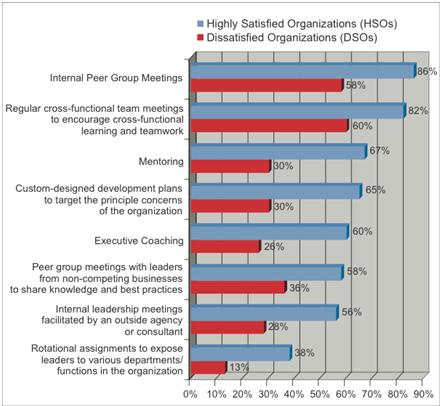Why Rely On Trickle-Down Leadernomics?

I’d like to kick-off the new year (and the start of my seventh year of blogging) with a post that will set the stage for much of what I plan to cover in 2012 – the world of executive development and, more specifically, peer advisory groups. If one were to characterize the philosophy behind executive development programs at many companies today, it would be Trickle-Down Leadernomics (an approach not unlike the economic theory): Traditional episodic training designed to stimulate positive behavioral changes, aimed to build better leaders who inspire commitment rather than mere compliance, in an effort to create a healthier culture, a more productive workplace, and happier employees whom you hope will one day perform like a well-oiled machine and drive double-digit growth and profitability for years to come. (Notice the amount of “trickle-down” it takes to achieve the desired result).
When you put it that way, it doesn’t sound very promising does it? That’s because it isn’t. The problem is that executives attend training programs (inside or outside the office), acquire a few new tools, learn some interesting concepts, and within a few weeks’ time, they’re back to the same old, pre-training behaviors. To be fair, our expectations may be a tad unrealistic.
Imagine sending your executives to golf camp for a week, where they receive new clubs, expert instruction, and discover a more proficient way to swing the club. Upon return to their home course, they eventually try their newfound swing, and after hitting the first few balls in the trees, they grow impatient (and a bit embarrassed). Left to their own devices, they revert to the way they’ve always swung the club because, by comparison, it feels far more reliable. (Though they did enjoy a week out of the office and now own a set of new golf clubs, the investment fell far short of the desired outcome).
Unfortunately, this scenario is far too common. John Dewey once wrote, “There is no such thing as educational value in the abstract.” So whether you want to improve your golf game or advance your leadership ability, adopting and perfecting new behaviors takes more than participating in a training exercise; it takes practice and discipline.
To take this hypothesis from the links to the C-suite, The Human Capital Institute (HCI) recently conducted a study of 463 of its members (executives from large, mid-sized, and small companies around the world) to learn how they are developing their leaders and to gauge their satisfaction with the results. The research was conducted in partnership with Vistage International. HCI divided the respondents into two groups: Highly Satisfied Organizations (HSOs) and Dissatisfied Organizations (DSOs).
HSOs (42% of survey respondents) are defined as those respondent organizations that are satisfied with both their established and new leader growth and development as leaders in the past two years. DSOs (58%) are defined as those organizations that expressed dissatisfaction with their established and/or new leader growth and development in the past two years.
HSOs were far more likely to augment their traditional executive development programs (periodic off-site leadership events or ad hoc training for specific purposes/skills development) with non-traditional development activities (ongoing mentoring, coaching, peer groups, cross-functional work teams, etc.).
Non-Traditional Development Activities
% Used Annually or More Often
According to HCI, “Both traditional and non-traditional methods of development are important considerations when designing an Executive Development Program. But, our research sought to further explore the effectiveness of such methods. It would seem that HSOs – that rely more on non-traditional methods of development and rate themselves as more satisfied with their senior leadership – are proponents of non-traditional activities, because such methods are more efficient at helping improve executive performance. And unsurprisingly, the data gleaned supports that hypothesis.”
“The survey results point not only to higher use of non-traditional activities among HSOs, but also reveal these activities to be much more effective…The most effective development techniques were activities characterized by an exchange of ideas with other individuals such as mentors, colleagues, and executive coaches.”
With myriad challenges facing today’s leaders, Trickle-Down Leadernomics won’t be enough. CEOs can’t simply cross their fingers and depend on gravity to assure that their investments in executive development find their way to sustainable growth. Behaviors can’t be taught; they have to be learned. And the only way most people learn and actually adopt new ways of working is by trying their newfound behaviors in “game situations,” working with their colleagues on their business, and achieving repeated success. So if you’re not systematically integrating learning with doing, it’s likely you’re not realizing the full benefit of your formal training program. I look forward to your comments and a robust conversation on this topic during the coming year!
Category: Leadership
Tags: executive coaching, executive development, HR, Leadership, Management, peer advisory groups, Training, trickle-down leadernomics


Searching bankruptcy court document are often boring and time consuming to go through, especially when you need to go through the records to find details of many, it is ideal to undertake the help of paid service providers.
Within those non-traditional methods of development, we found that an emphasis on cognitive performance resulted in huge gains to the organization in problem solving, reducing health-related risk and costs, and innovation toward revenue generation.
So far, there’s been lots of interest on this subject, but we’d love to learn more about how you’re managing executive development at your company. Comments welcome!